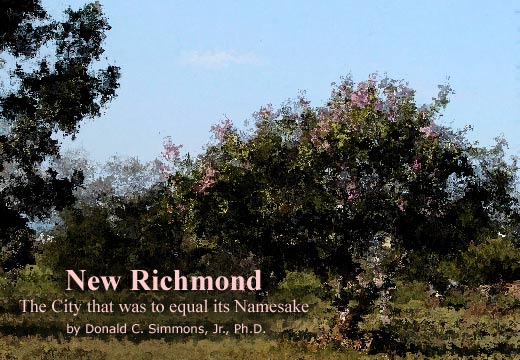It was the year 1869 and the rainy season converged on New Richmond, British Honduras. The creeks were swollen with swirling debris washed from their resting place by the seemingly endless deluge of water. In the fields that were being cleared by the remaining Confederate settlers from the United States, ash from the recently felled and burned jungle rushed toward Cotton Tree Bank Creek, riding on a wave of water saturated mud. One could only guess how long it would be before the rains began to cease and the tropical sun would again emerge uncontested, except for the occasional morning shower. B.R. Duval, who had envisioned the city that would "excel in wealth, wisdom, and prosperity its namesake," the capitol of the late Confederacy, was becoming increasingly frustrated by the deluge of water combined with the insects and fleas his family seemed to combat in a losing battle on a daily basis. |
||
New Richmond, located ironically just a short distance from Belmopan, the current capitol of Belize, was far from becoming a reality. Other Confederate settlers seeking refuge from the "oppressive" government in the United States had joined him in New Richmond, but only few. Most had joined Captain Armand Beauregard, brother of the famous Confederate General P.G.T. Beauregard, in Corosal, or John Wallace Price and others at Orange Walk. He had heard rumors that a new group of settlers had been recruited in an effort to revive the failing community of expatriates near Punta Gorda at Cattle Landing. Eleven communities of refugees from the Southern United States were at various stages of development throughout the British colony, but most were struggling to survive. The influx of thousands of settlers between 1865 and1869 had not produced the number of permanent residents expected by the crown and land speculators. Most were unable to survive in such and unfamiliar climate. |
||
Duval, a Methodist minister from Petersburg, Virginia, had originally settled in Mexico with General Sterling Price but was forced to leave the country as Maximilian's authority began to falter. While in New Orleans he had joined a party of other Southerners who were considering settlement in British Honduras, whose colonial government was by that time actively recruiting families from the Southern United States with promises of land at good terms and a climate that would grow almost anything one wanted to produce. It was while on that trip during the summer of 1867 that Duval decided to establish New Richmond at the intersection of Labouring Creek and Cut and Throw Away Creek.
Back in New Orleans, Duval began actively recruiting individuals
and families to join him in creating the new city. He wrote
articles in New Orleans newspapers that detailed his observations
about the colony. He encouraged readers to seek him out at his
temporary residence and to correspond with him as needed. More
than two hundred families expressed interest in joining him
as soon as the fall crop of cotton was out of the fields. He
notified all interested parties that he planned leave as soon
as possible for the colony so that much needed arrangements
would be made in advance of their arrival. Duval departed for the proposed site of New Richmond determined to realize his dream, and with every reason to believe his dream would become a reality. He established his family near the selected site in a house that had previously been used as a trading post. The poorly constructed structure had a dirt floor, was made of wood poles tied by vines, and only had a poorly constructed roof of leaves. Employing local Maya workers, he began clearing land for planting and the construction of temporary housing for the expected influx of immigrants. He traded with the Maya for hogs and other meat to supplement the readily available plantains and bananas. Duval refused to eat howler monkey, a favorite of some colonists, because they "looked too much like a child." One of the first settlers from the United States to join Duval and his family was General Colin J. McRae, brother of former Mississippi Governor John J. McRae, who purchased land to the South of New Richmond near Cotton Tree Bank. The General's estate consisted of eighteen square miles of land. During the American Civil War, McRae had served as the Confederate financial agent in Europe. The general had been unable to return to the United States because was wanted by authorities for the illegal sale of government property and various other alleged crimes. Another prominent settler to arrive in New Richmond during the summer of 1867 was Joseph Benjamin, younger brother of the former Confederate Secretary of State Judah P. Benjamin, who along with McRae, operated a cattle, mercantile, mahogany business, and store along Saturday Creek. Benjamin was not very good at managing his money, however, and McRae purchased his interest in their endeavor before Benjamin left to join Price and others settlers near Orange Walk. By the fall of 1867, it was becoming increasingly apparent that unless something could be done to resuscitate Duval's dying dream, New Richmond would not become a reality. Duval had been successful in recruiting two very prominent Confederates, but only a handful of other less prominent Southerners. Part of the reason for the lack of interest in the endeavor had been the removal of Lieutenant Governor Austin and the revocation of the exclusive monopoly of navigation rights by the Crown later that summer. The action by the Crown was a severe blow to his undertaking. Combined with the fact that most of the families who had responded so enthusiastically to his call of settlers had lost their cotton crops that year, the situation seemed hopeless. Duval continued throughout 1868 to try and encourage others to join him and General McRae in New Richmond with little success. His efforts appeared hopeless. Even the visit to the colony that year of former Mississippi Governor John McRae, who many hoped might create a renewed interest in the settlement, resulted in tragedy. Shortly after his arrival, which attracted considerable attention in the colonial and American press, Governor McRae became gravely ill and died a few days later, never seeing his brother or New Richmond. After all of his failed attempts to bring fellow expatriates to the British colony, the deluge of mud, insects, and frustration that came with the rainy season of 1869 was more than Duval could endure. Devastated, both emotionally and financially, Duval decided to abandon his efforts to recreate the city of Richmond, Virginia in British Honduras. Unable to purchase fares for his family, Duval left them with friends in the Belize City in November 1869 until he could raise the money for their passage in Virginia. The City that was to equal its namesake was not to become a reality. Colin McRae, the final remaining "citizen" of New Richmond, died at his estate is 1876. He refused to return to the United States or join other American communities in Orange Walk, Manatee, Stann Creek and Punta Gorda, Copyright 2003 by Donald C. Simmons, Jr. |
||


 Bull
Frog Inn, Belmopan, Belize
Bull
Frog Inn, Belmopan, Belize